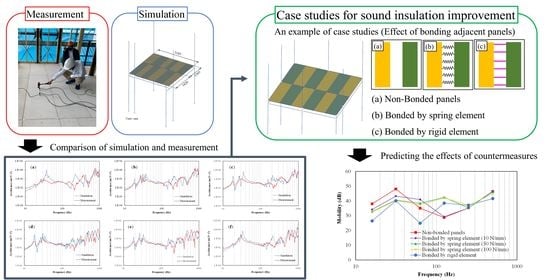Numerical Prediction Method for Vibration Characteristics of Steel-Framed Autoclaved Lightweight Aerated Concrete Floor Structures
Abstract
1. Introduction
2. Measurements
2.1. Methods
2.2. Results
3. Numerical Simulations
3.1. Numerical Method
3.2. Comparison of Measurement and Simulation Results
4. Case Studies
4.1. Effect of ALC Floor Panel Size
4.2. Effect of Beam Structure
4.3. Effect of Number of Beams
4.4. Effect of Bonding of Adjacent Panels
5. Limitations
6. Conclusions
Author Contributions
Funding
Institutional Review Board Statement
Informed Consent Statement
Data Availability Statement
Conflicts of Interest
References
- Ryuta, T.; Kyoko, A. Questionnaire survey on sound environment of apartment houses during stay home by COVID-19. AIJ J. Technol. Des. 2021, 27, 1303–1308. (In Japanese) [Google Scholar]
- Langdon, F.J.; Buller, I.B.; Scholes, W.E. Noise from neighbours and the sound insulation of party walls in house. J. Sound Vib. 1981, 79, 205–228. [Google Scholar] [CrossRef]
- Langdon, F.J.; Buller, I.B.; Scholes, W.W. Noise from neighbours and the sound insulation of party floors and walls in flats. J. Sound Vib. 1983, 88, 243–270. [Google Scholar] [CrossRef]
- Sho, K.; Katsuo, I.; Michiko, S.; Kazuhiro, F. Analysis of occupancy evaluation and behaviour as to multi-family dwelling sound environment. AIJ J. Archit. Plann. Environ. Eng. 1994, 466, 1–8. (In Japanese) [Google Scholar]
- Liu, C.; Fang, D.; Zhao, L. Reflection on earthquake damage of buildings in 2015 Nepal earthquake and seismic measures for post-earthquake reconstruction. Structures 2021, 30, 647–658. [Google Scholar] [CrossRef]
- Zhao, B.; Ke, K.; Liu, C.; Hong, L. Computational Model for the Flexural Capacity and Stiffness of Eccentric RHS X-Connections under Brace Out-of-Plane Bending Moment. J. Struct. Eng. 2020, 146, 04019227-1–04019227-15. [Google Scholar] [CrossRef]
- Liu, C.; Fang, D.; Zhao, L.; Zhou, J. Seismic fragility estimates of steel diagrid structure with performance-based tests for high-rise buildings. J. Build. Eng. 2022, 52, 104459. [Google Scholar] [CrossRef]
- Liu, C.; Fang, D. Robustness analysis of vertical resistance to progressive collapse of diagrid structures in tall buildings. Struct. Des. Tall Spec. Build. 2020, 29, e1775. [Google Scholar] [CrossRef]
- Sho, K.; Katsuo, I. Practical calculation of floor impact sound by impedance method. Appl. Acoust. 1989, 26, 263–292. [Google Scholar]
- Norihisa, H.; Mitsuhiro, K. Sound insulation of a rectangular thin membrane with additional weights. Appl. Acoust. 1991, 33, 21–43. [Google Scholar]
- Carl, H. Prediction of maximum time-weighted sound and vibration levels using transient statistical energy analysis. Part 1: Theory and numerical implementation. Acta Acust. United Acust. 2014, 100, 46–54. [Google Scholar]
- Carl, H.; Matthew, R. Prediction of maximum time-weighted sound and vibration levels using transient statistical energy analysis. Part 2: Experimental validation. Acta Acoust. United Acust. 2014, 100, 57–66. [Google Scholar]
- Susume, H.; Carl, H.; Pyoung, J.L. Impact sound insulation: Transient power input from the rubber ball on locally reacting mass-spring systems. In Proceedings of the Inter-Noise 2016, Hamburg, Germany, 21 August 2016. [Google Scholar]
- Susume, H.; Carl, H.; Pyoung, J.L. Comparison and assessment of Japanese, Korean and international measurement procedures for impact sound insulation with heavy impact sources. In Proceedings of the ICSV25, Hiroshima, Japan, 8–12 July 2018. [Google Scholar]
- Susume, H.; Carl, H. Prediction of heavy impact sounds using transient statistical energy analysis and finite element methods. In Proceedings of the ICSV25, Hiroshima, Japan, 8–12 July 2018. [Google Scholar]
- Yukiko, H.; Hikari, T.; Atsushi, T. Investigation method of heavy weight floor impact sound of large span slab focused on modeling procedure of the finite-element method. Rep. Taisei Tech. 2005, 38, 45-1–45-4. (In Japanese) [Google Scholar]
- Norihisa, H. Dynamical analysis in audio-frequency range of the beam-slabs by fem Study on floor slab vibrations and sound radiation Part 1. AIJ J. Archit. Plann. Environ. Eng. 1987, 372, 1–9. (In Japanese) [Google Scholar]
- Atsushi, N. Study on vibration and application of simulation technique for the floor impact sound based on both FEM floor vibration analysis and BEM sound field analysis. AIJ J. Archit. Plann. Environ. Eng. 1990, 521, 33–40. (In Japanese) [Google Scholar]
- Takashi, K.; Masanori, T.; Kei, A. Investigations on the prediction method of floor impact sound for large-span slabs focused on aspect ratio of slab plan. AIJ J. Archit. Plann. Environ. Eng. 2000, 537, 13–19. (In Japanese) [Google Scholar]
- Craik, R.J.M.; Steel, J.A.; Evans, D.I. Statistical energy analysis of structure-borne sound transmission at low frequencies. J. Sound Vib. 1991, 144, 95–107. [Google Scholar] [CrossRef]
- Churchill, C.; Hopkins, C. Prediction of airborne sound transmission across a timber–concrete composite floor using statistical energy analysis. Appl. Acoust. 2016, 110, 145–159. [Google Scholar] [CrossRef]
- McCollum, M.D.; Cuschieri, J.M. Bending and in-plane wave transmission in thick connected plates using statistical energy analysis. J. Acoust. Soc. Am. 1990, 88, 1480–1485. [Google Scholar] [CrossRef]
- Toyoda, M.; Takahashi, D. Prediction for architectural structure-borne sound by the finite-difference time domain method. Acoust. Sci. Technol. 2009, 30, 265–276. [Google Scholar] [CrossRef]
- Asakura, T.; Ishizuka, T.; Miyajima, T.; Toyoda, M. Numerical and experimental investigation on structure-borne sound transmission in multilayered concrete structures. J. Sound Vib. 2018, 413, 1–25. [Google Scholar] [CrossRef]
- Miyamura, T.; Ohsaki, M.; Kohiyama, M. Large-scale FE analysis of steel building frames using e-simulator (Selected papers of the Joint International Conference of Supercomputing in Nuclear Applications and Monte Carlo: SNA + MC 2010). Prog. Nuc. Sci. Tech. 2011, 2, 651–656. [Google Scholar] [CrossRef]
- Miyamura, T.; Yamashita, T.; Akiba, H.; Ohsaki, M. Dynamic FE simulation of four-story steel frame modeled by solid elements and its validation using results of full-scale shake-table test. Earthq. Eng. Struct. Dyn. 2015, 44, 1449–1469. [Google Scholar] [CrossRef]
- Tagawa, H.; Miyamura, T.; Yamashita, T.; Kohiyama, M.; Ohsaki, M. Detailed finite element analysis of full-scale four-story steel frame structure. Int. J. High-Rise Build. 2015, 4, 65–73. [Google Scholar]
- Park, J.-W.; Ha, T.-H.; Kim, H. Finite element modeling and experimental verification of lightweight steel floor vibration. J. Vibroeng. 2016, 18, 1435–1443. [Google Scholar] [CrossRef]
- Xu, L.; Tangorra, F.M. Experimental investigation of lightweight residential floors supported by cold-formed steel C-shape joists. J. Constr. Steel Res. 2007, 63, 422–435. [Google Scholar] [CrossRef]
- Parnell, R.; Davis, B.; Xu, L. Vibration performance of lightweight cold-formed steel floors. ASCE J. Struct. Eng. 2010, 136, 645–653. [Google Scholar] [CrossRef]
- Hoeller, C.; Zeitler, B.; Sabourin, I. Direct airborne and impact sound insulation of steel-framed floors for mid-rise constructions. In Proceedings of the Inter-Noise 2015, San Francisco, CA, USA, 9–12 August 2016. [Google Scholar]
- Hoeller, C.; Zeitler, B.; Sabourin, I. Airborne and Impact Sound Insulation Data for Cold-Formed Steel-Framed Walls and Floors; Report A1-005007.1; National Research Council Canada: Ottawa, ON, Canada, 2018. [Google Scholar]
- Zhang, S.; Xu, L. Vibration serviceability evaluation of lightweight cold-formed steel floor systems. Structures 2022, 38, 1368–1379. [Google Scholar] [CrossRef]
- Hikari, T.; Kiyoshi, M. Floor impact sounds by heavy impact source in steel structure buildings—Vibrational properties of floor slabs and prediction using FEM. Noise Cont. 2012, 36, 425–434. (In Japanese) [Google Scholar]
- Yu, A.; Norihisa, H. Study on natural vibration analysis of deck plate slabs and their conversion to flat plate -Numerical analysis on vibration and floor impact sound of deck plate slabs in steel structure buildings Part 1. AIJ J. Technol. Des. 2015, 21, 171–176. (In Japanese) [Google Scholar]
- Yu, A.; Norihisa, H. Study on prediction of vibration response of deck plate slabs—Numerical analysis on vibration and floor impact sound of deck plate slabs in steel structure buildings Part 2. AIJ J. Technol. Des. 2016, 22, 153–158. (In Japanese) [Google Scholar]
- Zhang, S.; Xu, L. Determination of equivalent rigidities of cold-formed steel floor systems for vibration analysis, Part I: Theory. Thin-Walled Struct. 2018, 132, 25–35. [Google Scholar] [CrossRef]
- Xu, L.; Zhang, S.; Yu, C. Determination of equivalent rigidities of cold-formed steel floor systems for vibration analysis, Part II: Evaluation of the fundamental frequency. Thin-Walled Struct. 2018, 132, 1–15. [Google Scholar] [CrossRef]
- Abramowicz, M.; Berczyński, S.; Wróblewski, T. Modelling and parameter identification of steel–concrete composite beams in 3D rigid finite element method. Archiv. Civ. Mech. Eng. 2020, 20, 103. [Google Scholar] [CrossRef]
- Scislo, L.; Guinchard, M. Non-invasive measurements of ultra-lightweight composite materials using Laser Doppler Vibrometry system. In Proceedings of the 26th International Congress on Sound and Vibration, Montréal, QC, Canada, 7–11 July 2019. [Google Scholar]
- Scislo, L. Quality assurance and control of steel blade production using full non-contact frequency response analysis and 3D laser doppler scanning vibrometry System. In Proceedings of the 11th IEEE International Conference on Intelligent Data Acquisition and Advanced Computing Systems: Technology and Applications, Cracow, Poland, 22–25 September 2021. [Google Scholar]
- Narayanan, N.; Ramamurthy, K. Structure and properties of aerated concrete: A review. Cem. Concr. Compos. 2000, 22, 321–329. [Google Scholar] [CrossRef]
- ALC Association. ALC Panel Structural Design Guideline and Commentary. 2013. (Translated from Japanese). Available online: http://www.alc-a.or.jp/pdf/alc_planguide.pdf (accessed on 20 September 2022).
- Sho, K.; Katsuo, I.; Mitsuo, O. Methods for improving the performance of floor impact sound insulation for heavy impact source in steel frame ALC-type dwellings. AIJ J. Archit. Plann. Environ. Eng. 1997, 496, 15–21. (In Japanese) [Google Scholar]
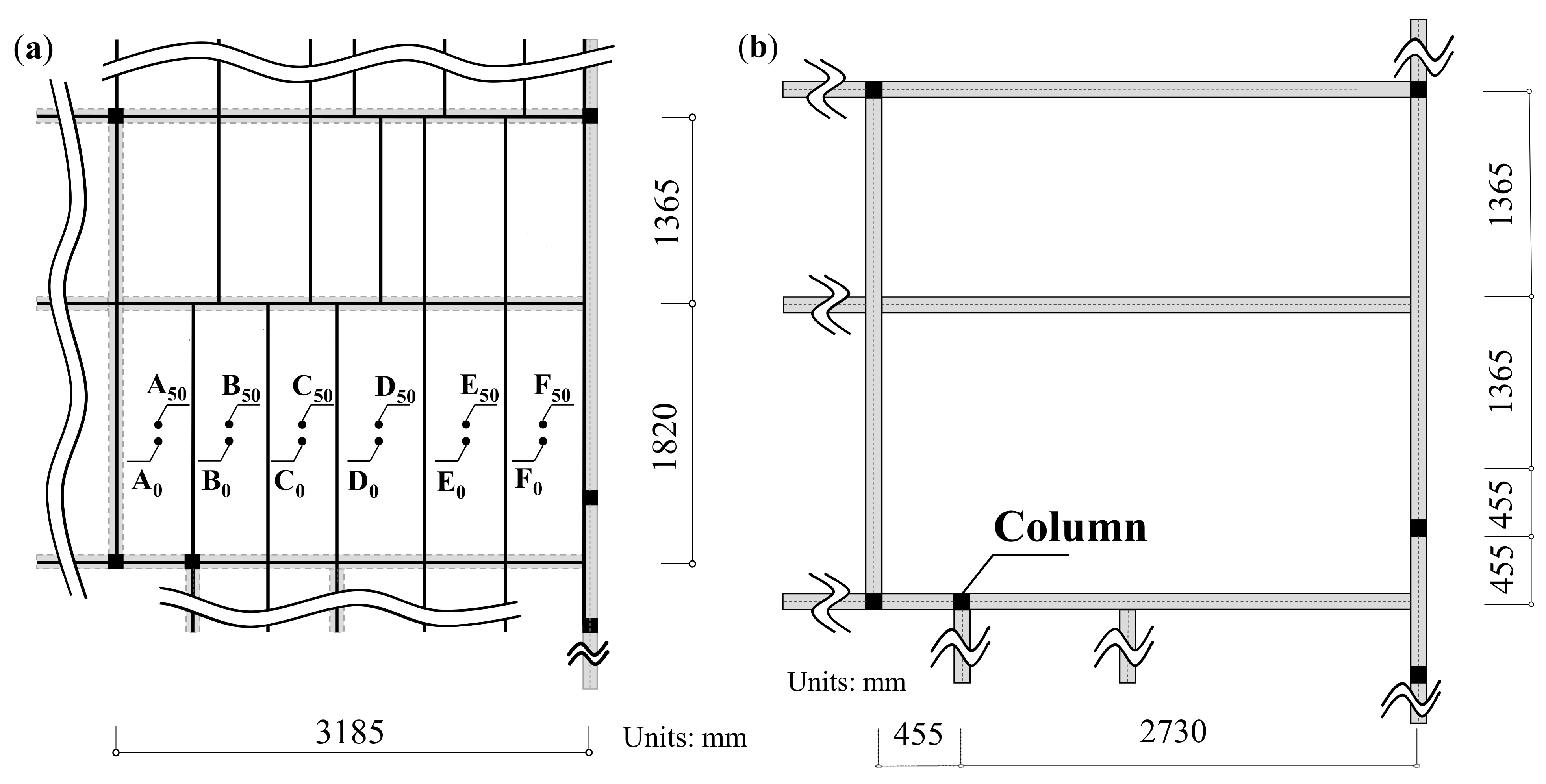
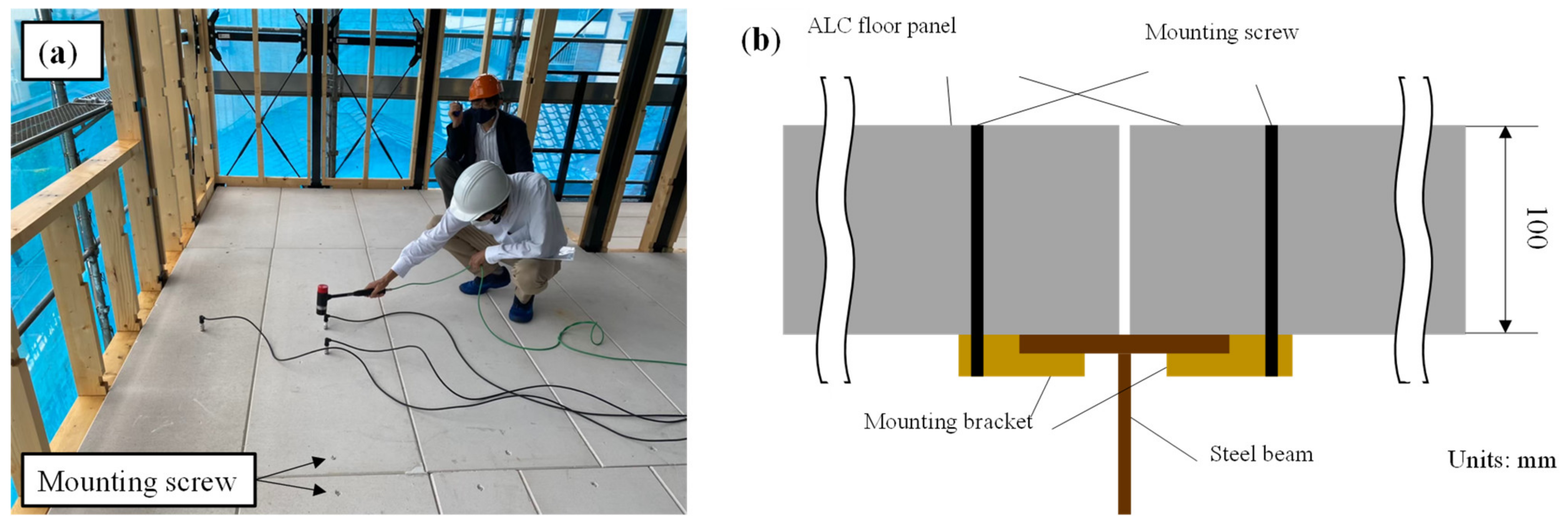

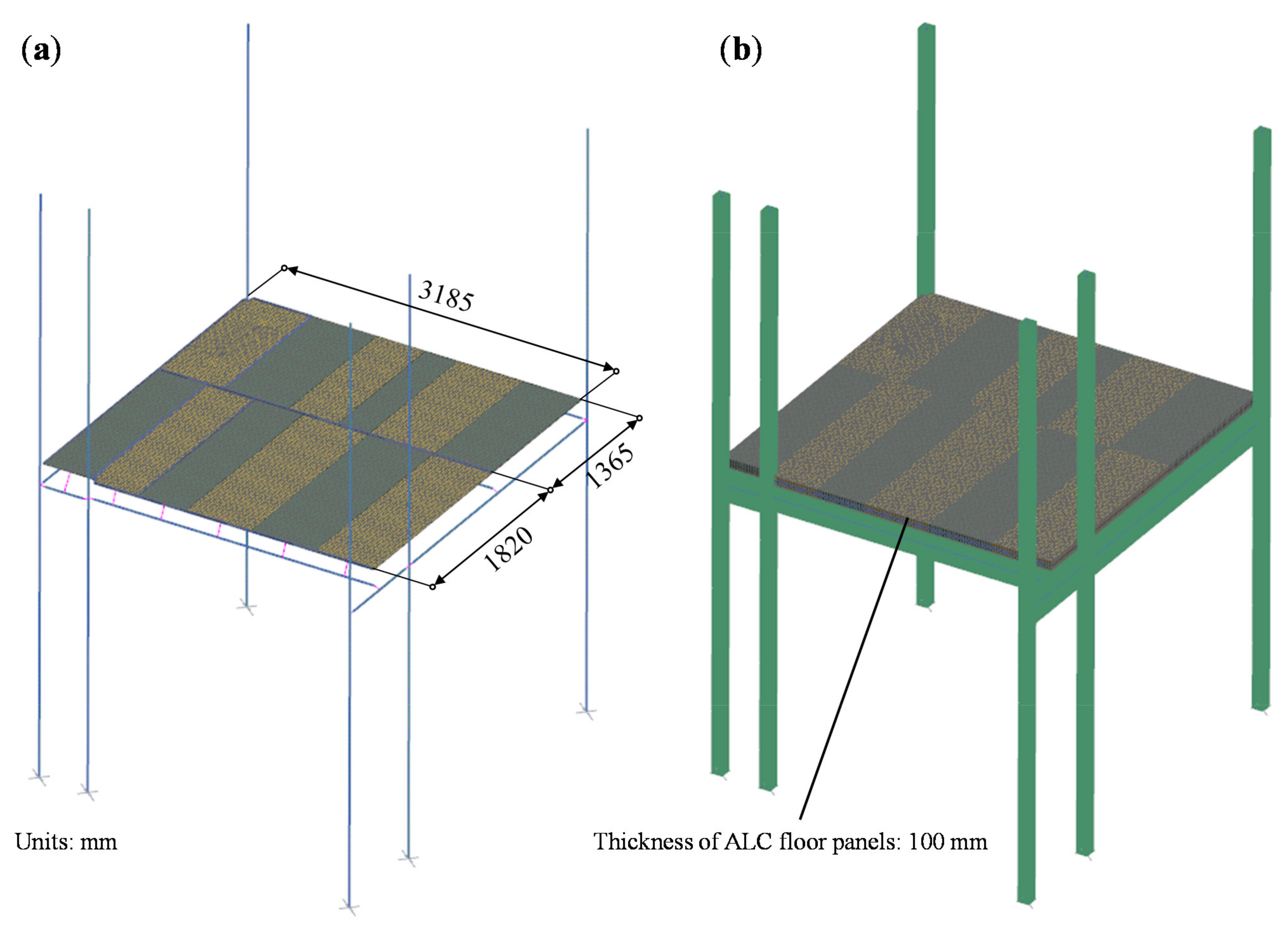


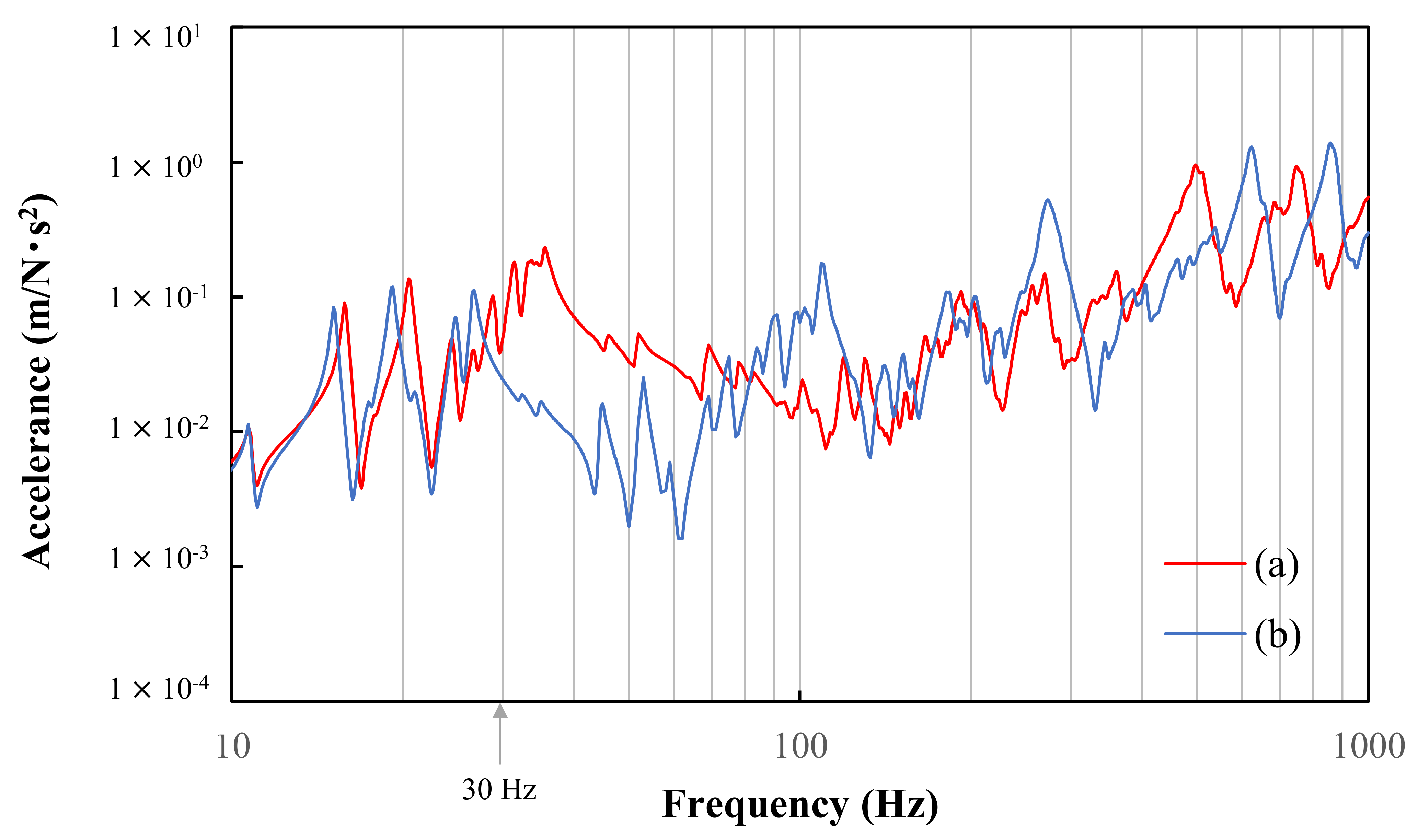

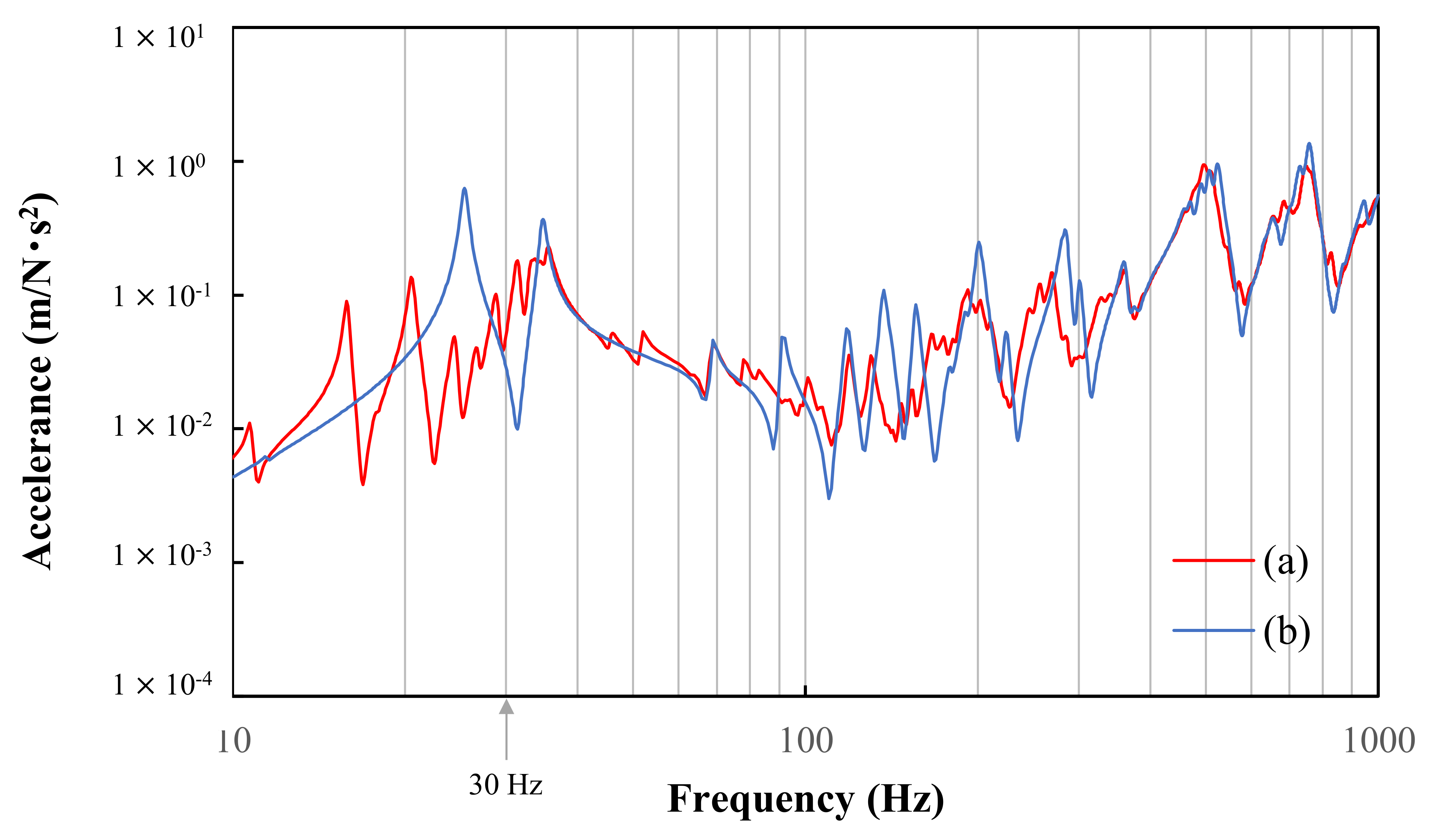




| Property | ALC Floor Panels | Columns and Steel Frames |
|---|---|---|
| Young’s modulus | 1.75 × 109 N/m2 | 2.00 × 1011 N/m2 |
| Poisson’s rato | 0.2 | 0.3 |
| Density | 650 kg/m3 | 7850 kg/m3 |
| Damping ratio | 0.03 | 0.02 |
Publisher’s Note: MDPI stays neutral with regard to jurisdictional claims in published maps and institutional affiliations. |
© 2022 by the authors. Licensee MDPI, Basel, Switzerland. This article is an open access article distributed under the terms and conditions of the Creative Commons Attribution (CC BY) license (https://creativecommons.org/licenses/by/4.0/).
Share and Cite
Mizunuma, H.; Asakura, T.; Ishiwatari, Y.; Shiraishi, T.; Satoh, F. Numerical Prediction Method for Vibration Characteristics of Steel-Framed Autoclaved Lightweight Aerated Concrete Floor Structures. Buildings 2022, 12, 1910. https://doi.org/10.3390/buildings12111910
Mizunuma H, Asakura T, Ishiwatari Y, Shiraishi T, Satoh F. Numerical Prediction Method for Vibration Characteristics of Steel-Framed Autoclaved Lightweight Aerated Concrete Floor Structures. Buildings. 2022; 12(11):1910. https://doi.org/10.3390/buildings12111910
Chicago/Turabian StyleMizunuma, Haruki, Takumi Asakura, Yasuhiko Ishiwatari, Takayuki Shiraishi, and Fumiaki Satoh. 2022. "Numerical Prediction Method for Vibration Characteristics of Steel-Framed Autoclaved Lightweight Aerated Concrete Floor Structures" Buildings 12, no. 11: 1910. https://doi.org/10.3390/buildings12111910
APA StyleMizunuma, H., Asakura, T., Ishiwatari, Y., Shiraishi, T., & Satoh, F. (2022). Numerical Prediction Method for Vibration Characteristics of Steel-Framed Autoclaved Lightweight Aerated Concrete Floor Structures. Buildings, 12(11), 1910. https://doi.org/10.3390/buildings12111910







